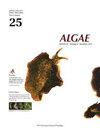Statistical optimization of phytol and polyunsaturated fatty acid production in the Antarctic microalga Micractinium variabile KSF0031
IF 2.4
3区 生物学
Q1 MARINE & FRESHWATER BIOLOGY
引用次数: 4
Abstract
Polar microorganisms produce physiologically active substances to adapt to harsh environments, and these substances can be used as biomedical compounds. The green microalga Micractinium variabile KSF0031, which was isolated from Antarctica, produced phytol, a natural antimicrobial agent. Furthermore, several polyunsaturated fatty acids (PUFAs), including omega-3, exhibit antioxidant properties. Here statistical methods (Plackett-Burman design and Box- Behnken design) were used to optimize the culture medium of KSF0031 to improve biomass production, and K2HPO4, MgSO4·7H2O, and ammonium ferric citrate green (AFCg) were selected as significant components of the culture medium. Changes in the concentration of K2HPO4 and MgSO4·7H2O as positive factors and AFCg as a negative factor affected cell growth to a remarkable degree. The biomass production in a 100 L culture using the optimized medium for 24 d at 18°C was improved by 37.5% compared to that obtained using the original BG-11 medium. The quantities of PUFAs and phytol obtained were 13 mg g-1 dry cell weight (DCW) and 10.98 mg g-1 DCW, which represent improved yields of 11.70% and 48.78%, respectively. The results of this study could contribute to an improved production of phytol and fatty acids from Antarctic microalgae in the biomedical industry.南极微藻KSF0031产叶绿醇和多不饱和脂肪酸的统计优化
极地微生物产生生理活性物质来适应恶劣的环境,这些物质可以用作生物医学化合物。从南极分离得到的绿色微藻可变Micractinium variabile KSF0031产生了一种天然抗菌剂phytol。此外,包括ω-3在内的几种多不饱和脂肪酸(PUFA)具有抗氧化特性。采用统计学方法(Plackett-Burman设计和Box-Behnken设计)对KSF0031的培养基进行优化,以提高生物量产量,并选择K2HPO4、MgSO4·7H2O和柠檬酸铁铵绿(AFCg)作为培养基的重要成分。K2HPO4和MgSO4·7H2O作为阳性因子,AFCg作为阴性因子的浓度变化对细胞生长有显著影响。与使用原始BG-11培养基相比,使用优化培养基在18°C下培养24天的100L培养基中的生物量产量提高了37.5%。获得的PUFA和植物醇的量分别为13mg g-1干细胞重量(DCW)和10.98mg g-1 DCW,这分别代表11.70%和48.78%的产率提高。这项研究的结果可能有助于在生物医学工业中提高南极微藻的植物醇和脂肪酸产量。
本文章由计算机程序翻译,如有差异,请以英文原文为准。
求助全文
约1分钟内获得全文
求助全文
来源期刊

Algae
PLANT SCIENCES-
CiteScore
5.10
自引率
25.00%
发文量
18
期刊介绍:
ALGAE is published by the Korean Society of Phycology and provides prompt publication of original works on phycology. ALGAE publishes articles on all aspects of phylogenetics and taxonomy, ecology and population biology, physiology and biochemistry, cell and molecular biology, and biotechnology and applied phycology. Checklists or equivalent manu-scripts may be considered for publication only if they contribute original information on taxonomy (e.g., new combinations), ecology or biogeography of more than just local relevance. Contributions may take the form of Original Research Articles, Research Notes, Review Articles and Book Reviews.
 求助内容:
求助内容: 应助结果提醒方式:
应助结果提醒方式:


